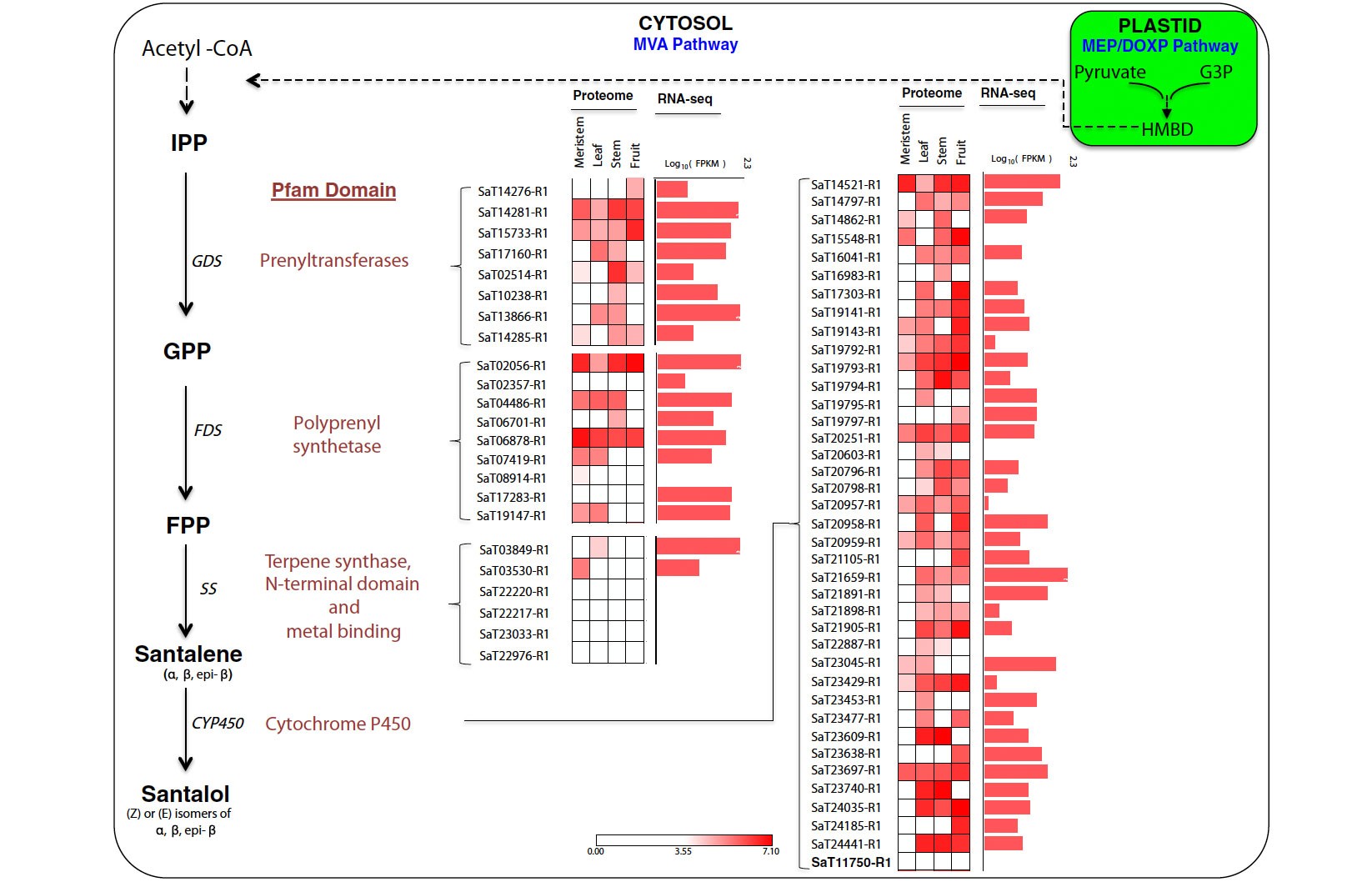博文
Plant Physiology:印度檀香基因组
||
Multi-omics driven assembly and annotation of the sandalwood (Santalum album) genome
First author: H.B. Mahesh; Affiliations: TransDisciplinary University (印度跨学科大学): Karnataka, India
Corresponding author: Malali Gowda
Santalum album (Indian sandalwood; 印度檀香) is an important tropical evergreen tree (热带常绿树种), known for its fragrant (芳香的) heartwood-derived (心材) essential oil (精油) and its valuable carving wood (木刻材料). Here, we applied an integrated genomic, transcriptomic, and proteomic approach to assemble and annotate the Indian sandalwood genome. Our genome sequencing resulted in the establishment of a draft map of the smallest genome for any woody tree species to date (221 Mb). The genome annotation predicted 38,119 protein-coding genes and 27.42% repetitive DNA elements. In-depth (深入的) proteome analysis revealed the identities of 72,325 unique peptides, which confirmed 10,076 of the predicted genes. Addition of transcriptomic and proteogenomic approaches resulted in the identification of 53 novel proteins and 34 gene-correction events that were missed by genomic approaches. Proteogenomic analysis also helped in reassigning 1,348 potential non-coding RNAs as bona fide (真正的) protein-coding mRNAs. Gene expression patterns at RNA and protein levels indicated that peptide sequencing was useful in capturing proteins encoded by nuclear and organellar genomes alike. Mass spectrometry-based (质谱分析) proteomic evidence provided an unbiased approach towards identification of proteins encoded by organellar genomes. Such proteins are often missed in the transcriptome dataset due to enrichment of only mRNAs that contain poly-A tails. Overall, use of integrated -omic approaches enhanced the quality of assembly and annotation of this non-model plant genome. Availability of genomic, transcriptomic, and proteomic data will enhance genomics-assisted breeding (基因组辅助育种), germplasm characterization, and conservation of sandalwood trees.
印度檀香是一种重要的热带常绿树种,因其心材提炼的芳香精油及用作木刻的木材而闻名。作者整合了基因组学、转录组学以及蛋白组学的方法用以组装和注释印度檀香的基因组。通过这一系列的方法,作者获得了目前为止木本植物中最小的一个基因组草图,基因大小为221Mb。基因组注释共预测到了38119个蛋白编码基因和27.42%的重复序列元件。深入的蛋白组分析鉴定了72325个特有的多肽,并验证了10076个预测的基因。另外的转录组和蛋白组分析共鉴定了53个新的基因,并纠正了34注释错误。蛋白组学的分析还重新定义了之前的1348个非编码RNA作为真的蛋白编码mRNA。RNA和蛋白水平的基因表达模式显示肽测序可以作为捕获由核或者细胞器基因编码的蛋白的有效方法。基于质谱分析的蛋白鉴定提供了一个无偏蛋白鉴定方法,可用于鉴定由细胞器所编码的蛋白。由于转录组仅能够富集含poly-A尾巴的mRNA,所以这些蛋白在转录组数据中会丢失。综上,利用多组学的综合鉴定方法增加了非模式植物的组装和注释质量。本文所提供的基因组、转录组以及蛋白组的信息有利于以后对于印度檀香的基因组辅助育种、种质鉴定以及保存。
通讯:Malali Gowda (http://tdu.edu.in/faculty/malali/)
个人简介:1990-1994年,印度农业科学大学,学士,方向:农业;1994-1996年,印度农业科学大学,硕士,方向:植物育种及遗传;1997-2002年,印度Maharaja Sayajirao大学,博士,方向:微生物学;2002-2005年,俄亥俄州立大学,博士后;2006-2008年,北卡罗来纳州立大学,博士后。
研究方向:植物与病原菌互作的分子研究;人类与植物的微生物组学研究;利用组学的方法对传统医学再研究;基因组及生物信息方向的软件开发;组学数据库开发。
doi: https://doi.org/10.1104/pp.17.01764
Journal: Plant Physiology
First Published date: 12 February, 2018
(P.S. 欢迎关注微信公众号:微信号Plant_Frontiers)
https://blog.sciencenet.cn/blog-3158122-1099837.html
上一篇:PLOS Genetics:SAP基因调控拟南芥的器官大小
下一篇:Plant Biotechnol J:玉米STK基因参与花粉发育的分子调控
全部作者的其他最新博文
- • Plant Physiology:CsMADS3促进柑果中的叶绿素降解和类胡萝卜素合成(华中农业大学)
- • Molecular Plant:LBD11-ROS反馈调节作用于拟南芥的维管形成层增殖和次生生长(浦项科技大学)
- • Science Advances:根结线虫通过调控植物的CLE3-CLV1模块,促进侵染进程(日本熊本大学)
- • Nature Communications:油菜素内酯参与植物营养生长期转变的分子机制解析(浙江农林大学)
- • Current Biology:光合作用产生的蔗糖驱动侧根“生物钟”(德国弗莱堡大学)
- • PNAS:花同源异型基因在叶中被抑制、花中被激活的分子机制(南卡罗来纳大学)

